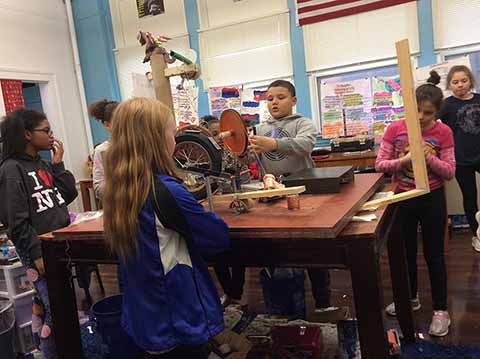How to Prepare for Your First ExploraVision
As educators, we are so tightly bound to old traditions and methods that it can seem daunting to experiment with new ways of teaching. If we truly want to prepare modern learners for the world they will eventually be leading, it’s our responsibility to adapt our teaching strate-gies. For exactly that reason, I chose to step out of my comfort zone last year and present my students with a new learning opportunity: the ExploraVision program.
ExploraVision offers students the chance to step outside the conventional learning institu-tion and engage directly with topics that impact their own lives and the world at large. It’s a ve-hicle for developing the critical-thinking skills and creativity that will be vital for the future workforce.
If starting this program in your classroom sounds intimidating, don’t worry – it was for me too. Below, I’ve laid out some of the tips I gathered during our first year participating in
ExploraVision.
Advice for ExploraVision First-Timers

My fifth graders hard at work on their ExploraVision projects
Introducing ExploraVision
For starters, I recommend launching the ExploraVision program when student enthusiasm and engagement is likely to be at a peak. I introduced ExploraVision right after Christmas break, while my students were still buzzing with excitement from the holiday season. The excitement they brought back into the classroom was a natural segue into trying something new and exciting! This could also work excellently at the beginning of the school year.
The length and intensity of the program can be adjusted to fit the specific needs of your classroom. I ran ExploraVision following the two-month program sample timeline, which worked well for my fifth graders who generally need less guidance to complete assignments. Younger students may necessitate more time and coordination, in which case, the program could be im-plemented on a larger scale.
Guiding Students Through the Process
When it comes time for your classroom to form ExploraVision teams, it’s helpful to group students strategically based on their skill sets. For example, each team would benefit from having one strong written and oral communicator and one strong creative thinker. The key is to encour-age students to collaborate through critical thinking and creativity, which the format of Explo-raVision lends itself perfectly to.
In order to guide my students and assist them with organization and time management, I found Google Classroom to be incredibly helpful. I simply created an assignment tab inside of our virtual classroom for each student to store their progress. As the deadline for submissions ap-proached, my students were thrilled to have all of their information in a central, organized loca-tion!
Takeaways from Our First ExploraVision Experience
If there is one thing I will take away from our first ExploraVision experience, it’s the lev-el of engagement I witnessed in my students. I’ve always been a firm believer that almost all of the behavioral issues we see in schools could be solved by focusing on student engagement. When students have agency over the structure and direction of their learning, their enthusiasm for the subject matter grows exponentially. I found ExploraVision to be an excellent vehicle for delivering and facilitating this type of independence and engagement. Students are encouraged to explore the topics they feel most passionate about, and that passion is reflected in the quality of their work.
In fact, many of my students at Dubois Elementary have already asked if I would spon-sor them again next year, and I am currently working on implementing the program across 4th and 5th grade. I hope that my experience inspires other educators to bring this opportunity to their students.
Download these powerful K-12 science lesson plans to get started!
About the Author
Daniel Hartman is a fifth-grade teacher at Dubois Elementary School in Springfield, Illinois. This past year, he decided to implement the ExploraVision program into his curriculum. He hopes to be able to expand this opportunity throughout the fourth and fifth grade next year and inspire other educators to do the same in their schools.
